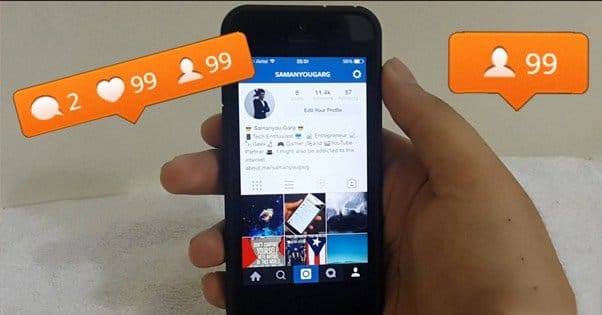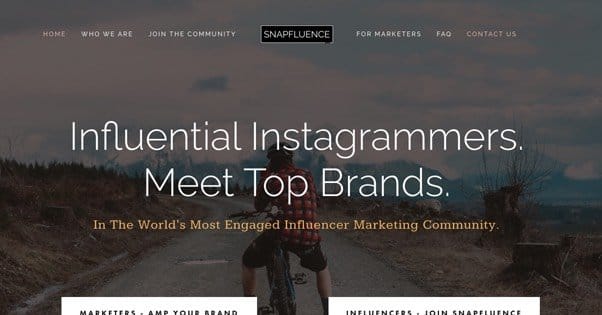 Written by ContentPowered.com
Written by ContentPowered.com
At first blush, it seems hard to monetize Instagram. The site is built around sharing pictures, and there’s not a whole lot else going on. There are tags and hashtags and photo comments, but you’re stuck using mobile for a lot of it, and you’re barely able to use third party apps. It’s difficult to even manage your account from a desktop rather than a mobile device. Using it for marketing is a relatively new and somewhat untapped market, but that shouldn’t turn you away. Think of yourself as a prospector looking for wild west gold, not as a cautious investor getting into the game when everyone has staked their claims.
Monetizing Instagram can be divided up into two main points; building an audience and establishing a monetization strategy. Without a good audience you can’t make money, and you can’t make money using a poor strategy. Thankfully, I’ve got you covered on both.
Establishing a Following Worth Monetizing
The number one piece of advice I can give you about making a monetizable audience is to avoid buying crappy Fiverr followers or bots at all costs. Bots are never going to buy anything and, since you can’t run PPM ads on Instagram, can’t possibly make you money in any way. Every penny you spend buying fake followers is a penny you’re throwing away.
Now, that’s not to say you can’t buy followers. You just have to be smart about it and use a real seller. Real follower sellers – hint hint – basically just have their own proprietary ad networks they can run to put your account in front of people you can’t normally reach. Those people will follow your account, and they’ll do it because your account is interesting, not because they’re programmed to or paid to like a clickfarm.
Buying followers isn’t the best way to grow a following, though. After all, it costs money to do so. If you’re looking to make money, you don’t want to build your following by starting in the hole. Take some time instead and focus on organic growth. Here are my best tips.
- Try to pick a specific niche for your content. If you’re already running a business or a blog, you have a niche, but your Instagram needs to be a sub-niche of that niche. Not everything about your industry is going to be photogenic; you need to pick the stuff that is. If your niche is inherently photogenic, like “food” for example, you need to specialize even further. Food, sure, but go deeper; specialize in photos of bento boxes or food sculptures, artistic gourmet food, juicy red meats, or something that can be boiled down to one delicious category. Oops, now I’m hungry.
- Post on a daily basis. Buffer did a study of various social networks and calculated what the ideal number of posts per day on each social network is. Instagram is unique in that 1-2 times a day is the ideal minimum, but there was no drop-off if you posted more. The only trick is, you need to keep up a level of activity. If you post five times per day, it better be five times per day all the time, not five times on Monday and once every other day. Pick a level you an adhere to, ideally 2-3 times per day in my opinion, and stick with it.
- Try to work in Instagram videos whenever possible, though you shouldn’t overdo it. One or two a week is probably a good maximum. Instagram videos are short like Vines, with a 15 second limit, and they can add a lot of depth and a lot of compelling imagery to an already image-heavy network. They also make you stand out; not everyone has the capability of creating high quality videos.
- Encourage participation. You’re centered around a narrow topic, so fans of that topic are going to be passionate about it. Encourage them to submit their content to your feed, and curate that content by liking and sharing it. When someone submits their content to your hashtags, like it. You can even consider following them to help encourage people to follow you.
- Don’t fall into the trap of using phone cameras and default filters. You’re going for a top-tier look, which means using top-tier tools. Don’t be afraid to take pictures, download them to your desktop, edit them to look amazing, and re-upload them to your phone for posting. You can use the unfiltered, raw look on occasion, but so many people rely on it that you need to stand out for the majority of your content.
- Watermark your images. This helps avoid most content theft – though not all – and it’s something you can use as an incentive for one of our later monetization ideas. I’ll cover that more in a bit. When watermarking images, use a small watermark in a location that makes it hard to remove or crop out. Don’t go the DeviantArt route and plaster a big logo over the center of your image; it ruins the look and dissuades people from sharing it.
- It’s probably not necessary to say, but make sure your profile is filled out completely and professionally. Avoid emojis and chatspeak. Make your profile image some of your best work; it’s there next to everything else you post, after all.
- Make sure to use hashtags – primarily general niche-relevant hashtags rather than branded tags – in the captions of your photos. How you specifically go about that will depend on your niche and the purpose of each individual picture, though.
- Tag other accounts in your photos. Try to tag influencers who will be interested to see the image. Avoid private accounts, accounts with no following, and accounts that don’t participate in your niche. Likewise, avoid the top 100 most popular accounts. Sure, a share from one of them would be great, but they’re absolutely inundated with content and probably will never see your post. Instead, it just looks like wishful fishing to your audience.
By establishing and maintaining a constant content routine with high quality content, you can become one of those very influencers people want to attract, and you can do it primarily organically. It just takes time, more than anything.
1. Include Links to Sales Funnels
What does almost all marketing have in common? Imagery! People sell products by showing you pictures of those products, by showing you pictures of users making great use out of them, or by showing you the glamour, beauty, or industrial quality of the products. Instagram, as a site focused solely on imagery with text and captions secondary, is an excellent place to start a sales funnel.
Now, no one is going to see your product on Instagram and say “I want to buy that.” Rather, they’re going to look at it and be curious. Alternatively, they might look at your brand and your style and think it meshes well with their lifestyle, and they want to know more about who you are and what you do. These are opportunities.
The trick is to have a sales funnel. Typically you’ll have a range of landing pages targeting different types of people or people who come in from different sources. You have, for example, people who are interested in your product and want to know more. Make a landing page about your product that tells them more, and link to it from photos that heavily feature your product. Make sure that landing page leads to storefront pages where the user can buy.
At the same time, you’re going to have pictures that have more to do with lifestyle than with the product itself. The people interested in these aren’t going to click a link to a product-focused landing page, or if they do, they’re going to bounce. Instead, you need a landing page about the lifestyle that gradually introduces the product and how it assists. Link to this landing page from those types of images, and have it convince people to register for mailing lists or get trial products.
A third type of image won’t have a good fit for a landing page; rather, it will be focused around a topic you cover in a blog post. In this case, link to the blog post, and rely on your on-site capture to get and keep those users around.
The point is, every image should have a link, and every link should lead to a type of page tailored to best fit with the audience and the image in question. Having a repertoire of possible landing pages for your sales funnel is where true success lies.
Obviously, this method only works to monetize your Instagram if you have something to sell. If you don’t, or if you want to make money independently with Instagram alone, the other methods are better for you.
2. Organize Contests with Minor Prizes
A lot of contests you see on Instagram, or on Facebook, or on Twitter, or on blogs, follow the same basic template. They have a single large prize and they try to get as many people to engage with them as possible in the hopes of winning the prize. The problem I see with that is, while a lot of people will sign up for the chance to win something big, you lose a lot of the cynics who figure they’ll never win and so they shouldn’t waste time entering.
I like two combine it with a small offer everyone can join, or a large number of people can join. You can have a single large prize, but you can also have 100 smaller prizes, like minor products or discount coupons. You can even offer a minor discount to everyone who enters, so long as you’re not losing profits if too many people claim them. The people who normally wouldn’t enter because they get nothing will now enter, because they get something minor that they can immediately use.
Contests serve two purposes. The first purpose is to get people to follow and engage with your profile. As they do so, your following grows, and you’re able to reach a wider audience. The second purpose is, obviously enough, to sell products. The primary contest winner will be a brand advocate, and even more so if they end up liking the prize. The secondary winners are more likely to convert than normal users, so that’s even more benefit.
3. Use an Instagram Matchmaker for Influence
Being associated with an Instagram matchmaker is a lot like being a publisher for an ad network.
It works like this.
- First, you build a following of sufficient size and power to be attractive to advertisers. Usually this is a certain minimum following and engagement level, though it will vary from matchmaker to matchmaker.
- Next, you find and sign up with a matchmaker. Companies like Snapfluence, Digital Media Management, and Mobile Media Lab all do this.
- Fill out your profile with these companies. This will mostly involve telling them some analytics data, like the demographics about your audience and the kind of content you normally post.
- The company will look through their repertoire of connections to find companies who are looking to advertise and who would benefit from finding an audience much like yours.
- The matchmaker will give you an offer from the company. Typically this offer will be something like X number of posts of their content with their caption – or a caption you write including their link – per week or per month. You get paid so long as you keep up your end of the contract.
This is very similar to two other monetization methods I’ll mention shortly, but I’ll tell you why they’re different when I get there.
The primary drawback of this method is that the matchmaker will take a cut; that’s how they get paid, after all. You also might end up looking like a shill if you get hooked up with the wrong type of contracts or you don’t know your audience as well as you thought you did. If you’re lucky, though, you’ll get paid by people you were already promoting out of love of the product.
4. Sell Prints of Instagram Photos
Instagram photos tend to be very artistic and visually pleasurable. That’s really the entire point of the site, right? If your pictures aren’t pleasant to look at, no one will look at them, and you fail at the entire foundation of the site.
Where else do people like artwork? Everywhere! They might want to use your image as a stock photo. They might want to hang it up on their wall. They might want it as part of a collage. They might just want a binder of interesting art they look at for inspiration.
You can cater to these people by selling your pictures. There are three ways to do this. The first is to offer non-exclusive rights to your photos as stock photos. You can do this in a number of different ways, but usually it will involve using a website to sell the rights and track the data.
The second method is to sell your images for advertising. There are services which allow you to sign up and allow brands to purchase rights to your photos for use in their advertising. Some of them focus on contests with prizes more than more guaranteed contracts. It’s up to you which you prefer.
The third method is focusing more on physical art, using services like Mobile Prints or Social Print Studio. These services take your images and allow you to sell prints to people who want them. They handle the printing on demand and the shipping, and they take a cut of the sale price in exchange. All you have to do is take the photos.
Remember how I mentioned watermarks as a tool? This was the monetization method I meant. You can offer the removal of the watermark, or non-watermarked prints, for sale and use. All it means is that you have to have the non-watermarked versions on hand for these services.
5. Sell Space and Time
No, you’re not literally selling reality. What you’re doing is selling digital real estate. Put a contact method for advertisers in your profile and focus on building a following. People will come to you asking if you can share their content. Refer them to your sales page.
The idea is this: you want to make money. Sell space in image captions, sell tags, sell hashtag uses, or even sell image placement. Offer packages that include them all. This is just selling sponsored ad space using your own system. It’s different from the method listed above because it doesn’t require a middleman, and thus you get to set your prices, attract your own customers, filter them to your heart’s content, and make sure they fit your feed as much as possible.
6. Run Affiliate Marketing on Instagram
Affiliate marketing is the final method, and it’s another that’s very much like the previous method, in that you’re getting companies to advertise on your feed. The difference is, you’re in complete control. Companies put out affiliate offers; it’s up to you to work them into your posting in a way that doesn’t stand out but still attracts people. Affiliate marketing on Instagram really isn’t much different from affiliate marketing on any other site, though, so I’m not going to go into great detail here. You can essentially just read this and apply the tips to Instagram instead.



